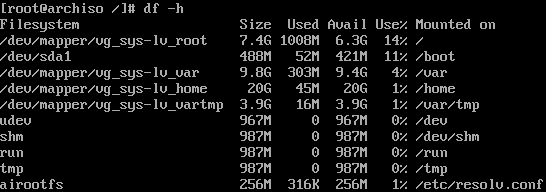Installing Arch
How to install Arch Linux (shorter/much less thorough than the official).
Preparing media
First you'll need to go get Arch. Be kind and use the torrent. If you're installing Arch onto a virtual machine you can simply mount the ISO file. If you're installing Arch onto a physical machine you're probably going to want to transfer the ISO to media.
USB
Linux
Run the following command, replacing /dev/sdx with your drive, e.g. /dev/sdc. (Do not append a partition number, so do not use something like /dev/sdc1)
dd bs=4M if=/path/to/archlinux.iso of=/dev/sdx status=progress oflag=sync
This irrevocably destroys all data on /dev/sdx and writes an iso9660 filesystem signature to the drive. To restore it as an empty, usable storage device after using the Arch ISO image, remove the signature by running the following command as root, before repartitioning and reformatting the USB drive.
wipefs --all /dev/sdx
Windows
Rufus is a multi-purpose USB ISO writer. Simply select the Arch Linux ISO, the USB drive you want to create the bootable Arch Linux onto and click start.
Since Rufus does not care if the drive is properly formatted or not and provides a GUI it may be the easiest and most robust tool to use. Be sure to select DD image mode or the image will be transferred incorrectly.
CD/DVD
Linux
Install cdrtools.
pacman -S cdrtools
Replace /dev/sr0 with your CD/DVD/BR burner's location.
cdrecord -v -sao dev=/dev/sr0 archlinux.iso
Windows
On modern versions of Windows, right click the ISO image and click Burn disc image. For older versions, search is your friend.
Create and format partitions
Once you've booted into the Arch ISO environment, you should check whether you're using UEFI mode by issuing the following command:
ls /sys/firmware/efi/efivars
If the directory does not exist, the system may be booted in BIOS or CSM mode. Refer to your motherboard's manual for details.
Your partition scheme is going to vary based on which mode your system is in. For BIOS machines I prefer to use the older MBR schema (unless the disk is over 2TB), while UEFI requires GPT. Any filesystems which users may fill should be separated from / such as /var and /home to maintain system stability in the event of user idiocy. For example if you know you're going to be hosting a user writable service under /srv/torrent, give it a partition of its own. Here are my bare minimum guidelines for a ~50GB hard drive, all partitions are ext4 unless otherwise noted:
- UEFI
/boot/efi # At least 100MB, must be FAT and set to EFI Partition / # 5GB+ /var # 10GB+ /var/tmp # 4GB+ /home # Remainder of the disk space
- BIOS
/boot # At least 100MB / # 5GB+ /var # 10GB+ /var/tmp # 4GB+ /home # Remainder of the disk space
You can use fdisk -l to list your recognized physical disks and fdisk /dev/sdX to make changes as necessary. LVM layouts are preferred for maintenance reasons later in the life of the machine. LVM is way more flexible and allows for some clever solutions to storage issues that can arise. Bootloaders may not like being on an LVM partition though, so we'll create a unique partition for it. Swap can be handled later by creating swap files . The following commands will create the layout and leave ~8GB (on a 50GB disk) to expand your LVMs as needed down the line.
- UEFI
root@archiso ~ # fdisk /dev/sda
g # Creates a new GPT partition table
n # Create a new partition
1 # This will be the first partition
[Enter] # Accept the default - should allow adequate space for alignment
+512M # Create a 512MiB /boot/efi partition
t # Set the partition type
1 # The code for 'EFI System' partitions
n # Create a new partition
2 # This will be the second partition
[Enter] # Accept the default
[Enter] # Consume the remainder of space on the drive
t # Set partition type
2 # Select the second partition
31 # The code for 'Linux LVM' partitions
w # Write these changes to the disk
root@archiso ~ # mkfs.fat -F32 /dev/sda1
root@archiso ~ # pvcreate /dev/sda2
root@archiso ~ # vgcreate vg_sys /dev/sda2
root@archiso ~ # lvcreate -L 7680M -n lv_root vg_sys # 7.5GB /
root@archiso ~ # lvcreate -L 10240M -n lv_var vg_sys # 10GB /var
root@archiso ~ # lvcreate -L 4096M -n lv_vartmp vg_sys # 4GB /var/tmp
root@archiso ~ # lvcreate -L 20480M -n lv_home vg_sys # 20GB /home
root@archiso ~ # mkfs -t ext4 -m 1 -v /dev/vg_sys/lv_root
root@archiso ~ # mkfs -t ext4 -m 1 -v /dev/vg_sys/lv_var
root@archiso ~ # mkfs -t ext4 -m 1 -v /dev/vg_sys/lv_vartmp
root@archiso ~ # mkfs -t ext4 -m 1 -v /dev/vg_sys/lv_home
- BIOS
root@archiso ~ # fdisk /dev/sda
o # Creates a new DOS/MBR partition table
n # Create a new partition
p # This will be a primary partition
1 # This will be the first partition
[Enter] # Accept the default - should allow adequate space for alignment
+512M # Create a 512MiB /boot partition
a # Set the bootable flag on the first partition
n # Create a new partition
p # This will be a primary partition
2 # This will be the second partition
[Enter] # Accept the default
[Enter] # Consume the remainder of space on the drive
t # Set partition type
2 # Select the second partition
8e # The code for 'Linux LVM' partitions
w # Write these changes to the disk
root@archiso ~ # mkfs -t ext4 -m 1 -v /dev/sda1
root@archiso ~ # pvcreate /dev/sda2
root@archiso ~ # vgcreate vg_sys /dev/sda2
root@archiso ~ # lvcreate -L 7680M -n lv_root vg_sys # 7.5GB /
root@archiso ~ # lvcreate -L 10240M -n lv_var vg_sys # 10GB /var
root@archiso ~ # lvcreate -L 4096M -n lv_vartmp vg_sys # 4GB /var/tmp
root@archiso ~ # lvcreate -L 20480M -n lv_home vg_sys # 20GB /home
root@archiso ~ # mkfs -t ext4 -m 1 -v /dev/vg_sys/lv_root
root@archiso ~ # mkfs -t ext4 -m 1 -v /dev/vg_sys/lv_var
root@archiso ~ # mkfs -t ext4 -m 1 -v /dev/vg_sys/lv_vartmp
root@archiso ~ # mkfs -t ext4 -m 1 -v /dev/vg_sys/lv_home
Mount the filesystems
Mount the filesystems to /mnt, and create mount points for any remaining partitions. For example:
- UEFI
root@archiso ~ # mount /dev/vg_sys/lv_root /mnt root@archiso ~ # mkdir -p /mnt/var /mnt/home /mnt/boot/efi root@archiso ~ # mount /dev/sda1 /mnt/boot/efi root@archiso ~ # mount /dev/vg_sys/lv_var /mnt/var root@archiso ~ # mount /dev/vg_sys/lv_home /mnt/home root@archiso ~ # mkdir /mnt/var/tmp root@archiso ~ # mount /dev/vg_sys/lv_vartmp /mnt/var/tmp
- BIOS
root@archiso ~ # mount /dev/vg_sys/lv_root /mnt root@archiso ~ # mkdir /mnt/var /mnt/home /mnt/boot root@archiso ~ # mount /dev/sda1 /mnt/boot root@archiso ~ # mount /dev/vg_sys/lv_var /mnt/var root@archiso ~ # mount /dev/vg_sys/lv_home /mnt/home root@archiso ~ # mkdir /mnt/var/tmp root@archiso ~ # mount /dev/vg_sys/lv_vartmp /mnt/var/tmp
Installation
Packages to be installed must be downloaded from mirror servers, which are defined in /etc/pacman.d/mirrorlist. Select a local one and disable/delete the others as this will greatly speed up your install in the following steps. This file will later be copied to the new system by pacstrap, so it's worth getting right.
Install the base packages
Use the pacstrap script to install the base package group:
pacstrap /mnt base
This group does not include all the tools from the live installation. You can append additional packages or groups such as dnsutils or net-tools to the pacstrap command. You can also install packages with pacman after the #Chroot step.
Configure the system
Fstab
Generate an fstab file (use -U or -L to define by UUID or labels, respectively):
genfstab -U /mnt >> /mnt/etc/fstab
Check the resulting file in /mnt/etc/fstab afterwards, and edit it in case of errors.
Chroot
Change root into the new system:
arch-chroot /mnt
Time zone
Set the time zone to your location. See the full current list under /usr/share/zoneinfo/. Here's an example for the US east coast:
ln -sf /usr/share/zoneinfo/America/New_York /etc/localtime
Locale
Uncomment en_US.UTF-8 and other needed localizations in /etc/locale.gen, and generate them with:
locale-gen
Set the LANG variable in locale.conf accordingly, for example:
echo "LANG=en_US.UTF-8" > /etc/locale.conf
Network configuration
Create the hostname file:
echo "bar" > /etc/hostname
...and matching entries in /etc/hosts
127.0.0.1 localhost 127.0.1.1 bar.localdomain.local bar
Don't forget to set an IP address if you need to.
Users and Passwords
Set the root password:
passwd
Add a new user to the system:
useradd foo passwd foo mkdir /home/foo chown foo:foo /home/foo
Sudo
Don't kid yourself and just install it now.
pacman -S sudo
Add your user to the /etc/sudoers file.
Mkinitcpio LVM
Edit /etc/mkinitcpio.conf and set the HOOKS line to:
HOOKS=(base systemd udev autodetect modconf block sd-lvm2 filesystems keyboard fsck)
Then generate new kernel images by issuing:
mkinitcpio -p linux
Boot loader
Ignore the rest, stick with the best. Install GRUB .
Double check your settings
At this point you have a system that looks something like this:
Reboot
Exit the chroot environment by typing exit or pressing Ctrl + D.
(Optional) Manually unmount all the partitions with umount -R /mnt: this allows noticing any "busy" partitions, and finding the cause with fuser.
Finally, restart the machine by typing reboot. Any partitions still mounted will be automatically unmounted by systemd. Remember to remove the installation media and then login to the new system with your user account.
(Optional) Set your DNS configuration up in /etc/resolv.conf:
nameserver 192.168.1.1 nameserver 8.8.8.8 search localdomain.local domain localdomain.local
Post-installation
See Linux and Networking for more tutorials on things to setup on your new system. Also check out Arch's General recommendations for more ideas.







